International Business Strategy Report: Module Overview and Analysis
VerifiedAdded on 2023/01/10
|7
|1585
|23
Report
AI Summary
This report provides a comprehensive overview of international business strategy, covering key concepts and frameworks discussed throughout a course. It begins by exploring the motives behind globalization, differentiating between push and pull factors influencing multinational companies. The report delves into the external macro-environment, utilizing tools such as PESTEL, Porter’s 5 Forces, and CAGE to analyze industry environments and competitive landscapes. It further examines the internal business environment, emphasizing resource-based strategies and the importance of aligning internal capabilities with market demands. The report also explores international expansion strategies, strategic alliances, and the barriers associated with internationalization, providing insights into how companies can achieve a competitive advantage in the global market. The analysis incorporates academic journals and readings, offering a well-rounded perspective on the subject.
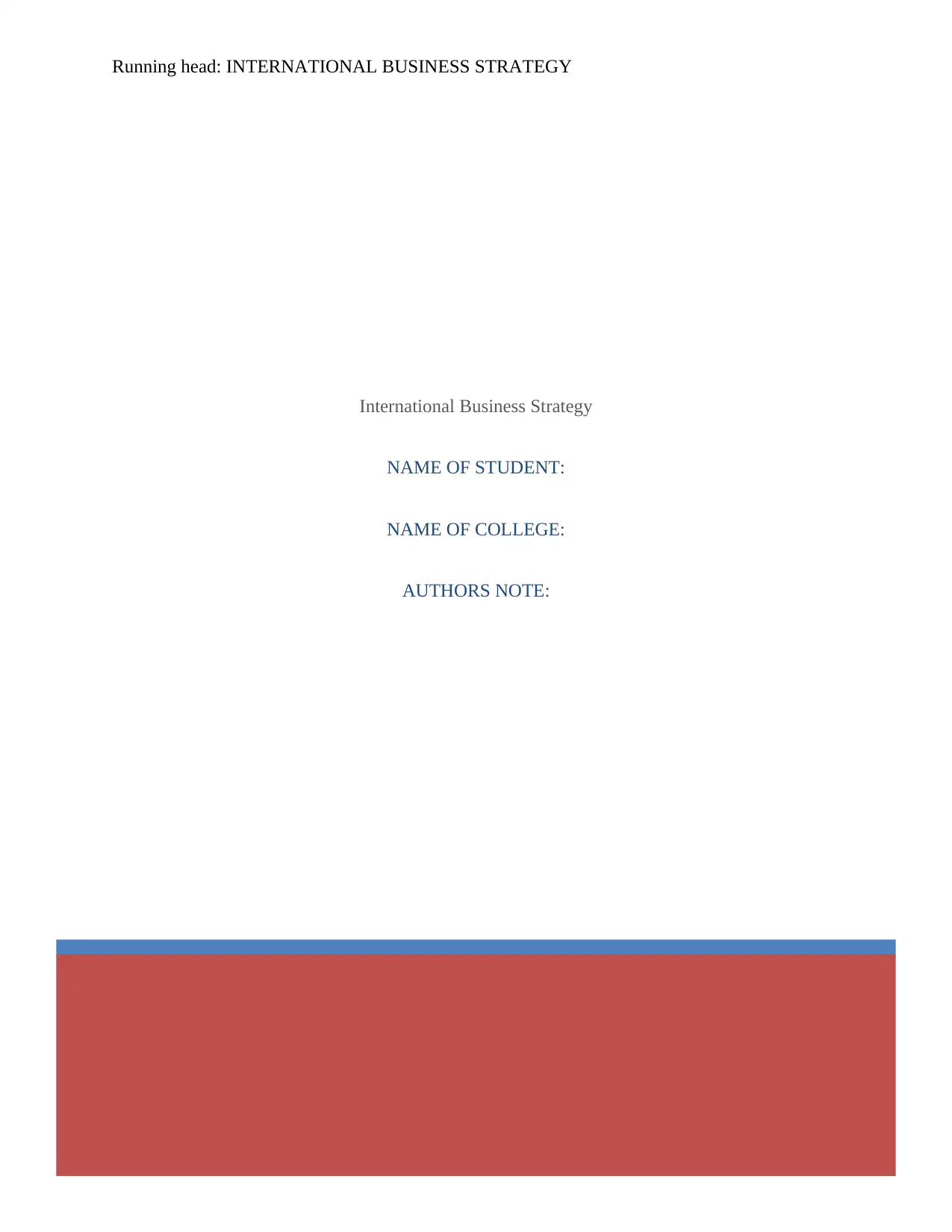
International Business Strategy
NAME OF STUDENT:
NAME OF COLLEGE:
AUTHORS NOTE:
Running head: INTERNATIONAL BUSINESS STRATEGY
NAME OF STUDENT:
NAME OF COLLEGE:
AUTHORS NOTE:
Running head: INTERNATIONAL BUSINESS STRATEGY
Paraphrase This Document
Need a fresh take? Get an instant paraphrase of this document with our AI Paraphraser
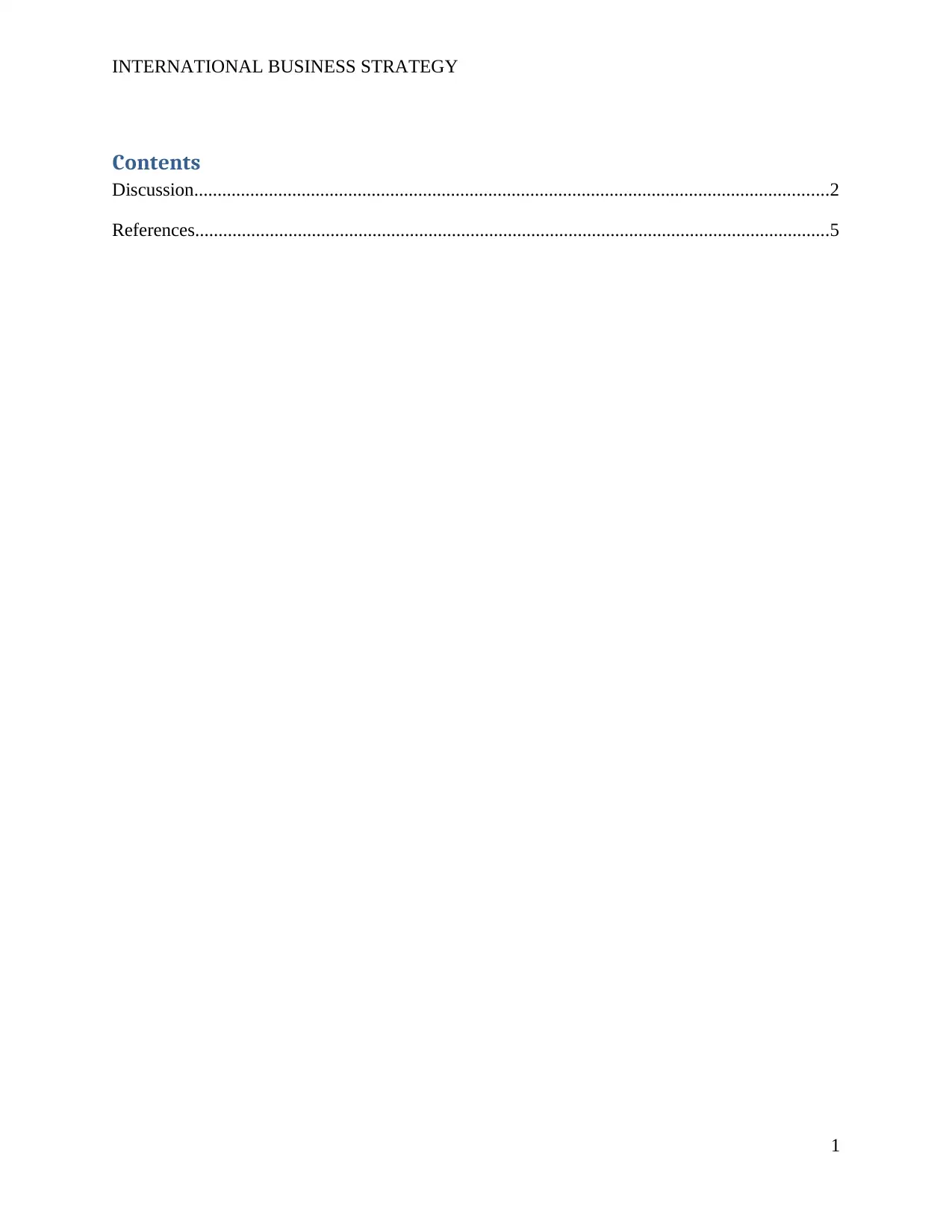
INTERNATIONAL BUSINESS STRATEGY
Contents
Discussion........................................................................................................................................2
References........................................................................................................................................5
1
Contents
Discussion........................................................................................................................................2
References........................................................................................................................................5
1
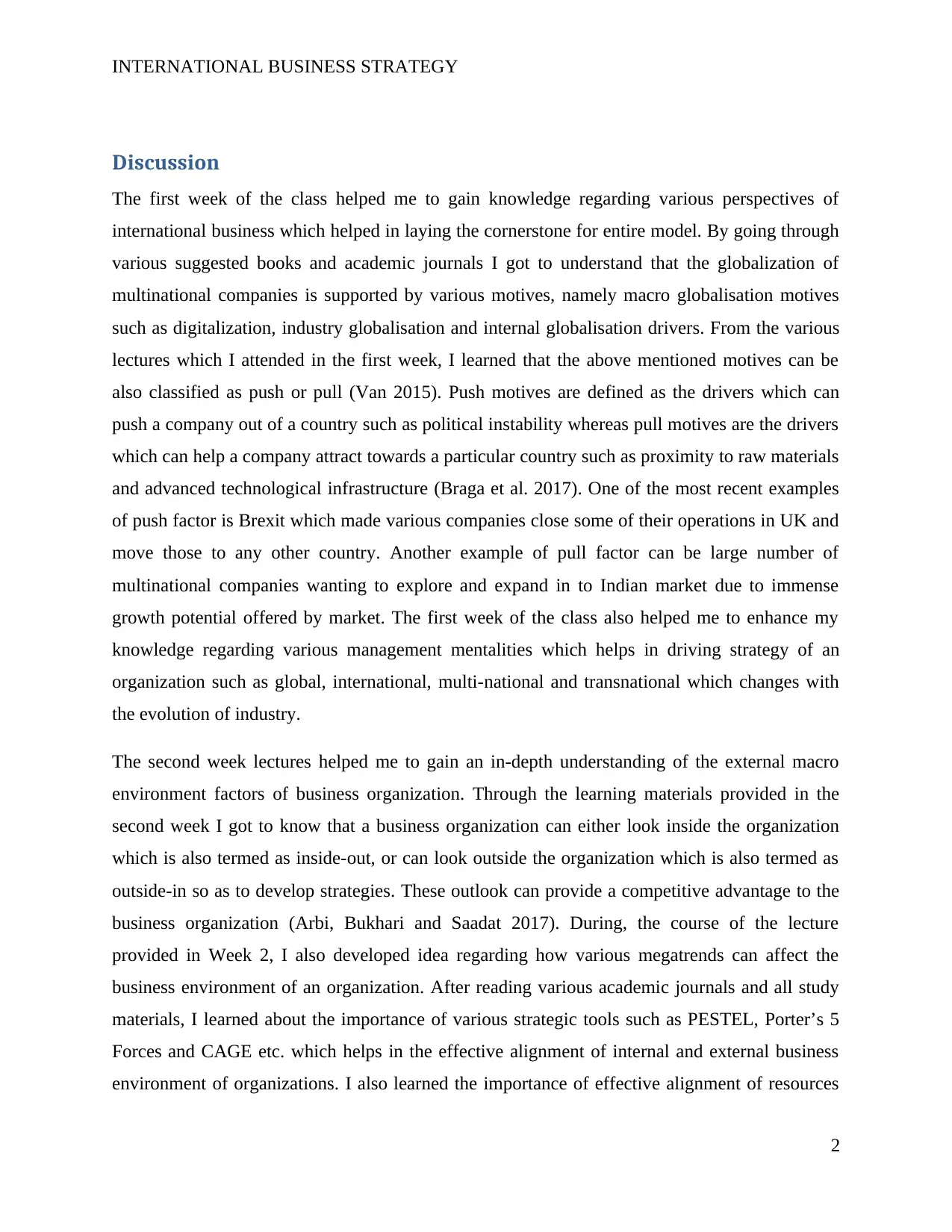
INTERNATIONAL BUSINESS STRATEGY
Discussion
The first week of the class helped me to gain knowledge regarding various perspectives of
international business which helped in laying the cornerstone for entire model. By going through
various suggested books and academic journals I got to understand that the globalization of
multinational companies is supported by various motives, namely macro globalisation motives
such as digitalization, industry globalisation and internal globalisation drivers. From the various
lectures which I attended in the first week, I learned that the above mentioned motives can be
also classified as push or pull (Van 2015). Push motives are defined as the drivers which can
push a company out of a country such as political instability whereas pull motives are the drivers
which can help a company attract towards a particular country such as proximity to raw materials
and advanced technological infrastructure (Braga et al. 2017). One of the most recent examples
of push factor is Brexit which made various companies close some of their operations in UK and
move those to any other country. Another example of pull factor can be large number of
multinational companies wanting to explore and expand in to Indian market due to immense
growth potential offered by market. The first week of the class also helped me to enhance my
knowledge regarding various management mentalities which helps in driving strategy of an
organization such as global, international, multi-national and transnational which changes with
the evolution of industry.
The second week lectures helped me to gain an in-depth understanding of the external macro
environment factors of business organization. Through the learning materials provided in the
second week I got to know that a business organization can either look inside the organization
which is also termed as inside-out, or can look outside the organization which is also termed as
outside-in so as to develop strategies. These outlook can provide a competitive advantage to the
business organization (Arbi, Bukhari and Saadat 2017). During, the course of the lecture
provided in Week 2, I also developed idea regarding how various megatrends can affect the
business environment of an organization. After reading various academic journals and all study
materials, I learned about the importance of various strategic tools such as PESTEL, Porter’s 5
Forces and CAGE etc. which helps in the effective alignment of internal and external business
environment of organizations. I also learned the importance of effective alignment of resources
2
Discussion
The first week of the class helped me to gain knowledge regarding various perspectives of
international business which helped in laying the cornerstone for entire model. By going through
various suggested books and academic journals I got to understand that the globalization of
multinational companies is supported by various motives, namely macro globalisation motives
such as digitalization, industry globalisation and internal globalisation drivers. From the various
lectures which I attended in the first week, I learned that the above mentioned motives can be
also classified as push or pull (Van 2015). Push motives are defined as the drivers which can
push a company out of a country such as political instability whereas pull motives are the drivers
which can help a company attract towards a particular country such as proximity to raw materials
and advanced technological infrastructure (Braga et al. 2017). One of the most recent examples
of push factor is Brexit which made various companies close some of their operations in UK and
move those to any other country. Another example of pull factor can be large number of
multinational companies wanting to explore and expand in to Indian market due to immense
growth potential offered by market. The first week of the class also helped me to enhance my
knowledge regarding various management mentalities which helps in driving strategy of an
organization such as global, international, multi-national and transnational which changes with
the evolution of industry.
The second week lectures helped me to gain an in-depth understanding of the external macro
environment factors of business organization. Through the learning materials provided in the
second week I got to know that a business organization can either look inside the organization
which is also termed as inside-out, or can look outside the organization which is also termed as
outside-in so as to develop strategies. These outlook can provide a competitive advantage to the
business organization (Arbi, Bukhari and Saadat 2017). During, the course of the lecture
provided in Week 2, I also developed idea regarding how various megatrends can affect the
business environment of an organization. After reading various academic journals and all study
materials, I learned about the importance of various strategic tools such as PESTEL, Porter’s 5
Forces and CAGE etc. which helps in the effective alignment of internal and external business
environment of organizations. I also learned the importance of effective alignment of resources
2
⊘ This is a preview!⊘
Do you want full access?
Subscribe today to unlock all pages.

Trusted by 1+ million students worldwide
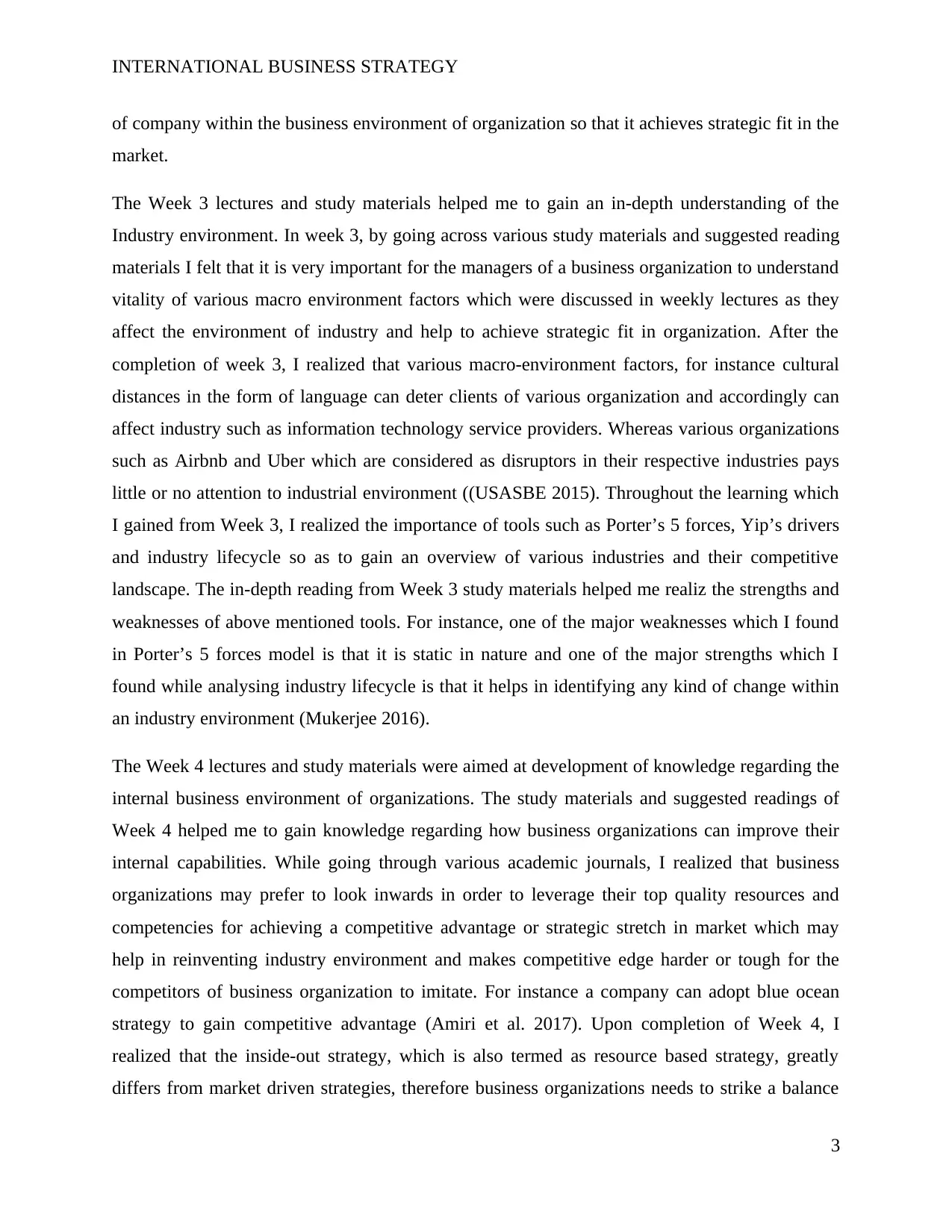
INTERNATIONAL BUSINESS STRATEGY
of company within the business environment of organization so that it achieves strategic fit in the
market.
The Week 3 lectures and study materials helped me to gain an in-depth understanding of the
Industry environment. In week 3, by going across various study materials and suggested reading
materials I felt that it is very important for the managers of a business organization to understand
vitality of various macro environment factors which were discussed in weekly lectures as they
affect the environment of industry and help to achieve strategic fit in organization. After the
completion of week 3, I realized that various macro-environment factors, for instance cultural
distances in the form of language can deter clients of various organization and accordingly can
affect industry such as information technology service providers. Whereas various organizations
such as Airbnb and Uber which are considered as disruptors in their respective industries pays
little or no attention to industrial environment ((USASBE 2015). Throughout the learning which
I gained from Week 3, I realized the importance of tools such as Porter’s 5 forces, Yip’s drivers
and industry lifecycle so as to gain an overview of various industries and their competitive
landscape. The in-depth reading from Week 3 study materials helped me realiz the strengths and
weaknesses of above mentioned tools. For instance, one of the major weaknesses which I found
in Porter’s 5 forces model is that it is static in nature and one of the major strengths which I
found while analysing industry lifecycle is that it helps in identifying any kind of change within
an industry environment (Mukerjee 2016).
The Week 4 lectures and study materials were aimed at development of knowledge regarding the
internal business environment of organizations. The study materials and suggested readings of
Week 4 helped me to gain knowledge regarding how business organizations can improve their
internal capabilities. While going through various academic journals, I realized that business
organizations may prefer to look inwards in order to leverage their top quality resources and
competencies for achieving a competitive advantage or strategic stretch in market which may
help in reinventing industry environment and makes competitive edge harder or tough for the
competitors of business organization to imitate. For instance a company can adopt blue ocean
strategy to gain competitive advantage (Amiri et al. 2017). Upon completion of Week 4, I
realized that the inside-out strategy, which is also termed as resource based strategy, greatly
differs from market driven strategies, therefore business organizations needs to strike a balance
3
of company within the business environment of organization so that it achieves strategic fit in the
market.
The Week 3 lectures and study materials helped me to gain an in-depth understanding of the
Industry environment. In week 3, by going across various study materials and suggested reading
materials I felt that it is very important for the managers of a business organization to understand
vitality of various macro environment factors which were discussed in weekly lectures as they
affect the environment of industry and help to achieve strategic fit in organization. After the
completion of week 3, I realized that various macro-environment factors, for instance cultural
distances in the form of language can deter clients of various organization and accordingly can
affect industry such as information technology service providers. Whereas various organizations
such as Airbnb and Uber which are considered as disruptors in their respective industries pays
little or no attention to industrial environment ((USASBE 2015). Throughout the learning which
I gained from Week 3, I realized the importance of tools such as Porter’s 5 forces, Yip’s drivers
and industry lifecycle so as to gain an overview of various industries and their competitive
landscape. The in-depth reading from Week 3 study materials helped me realiz the strengths and
weaknesses of above mentioned tools. For instance, one of the major weaknesses which I found
in Porter’s 5 forces model is that it is static in nature and one of the major strengths which I
found while analysing industry lifecycle is that it helps in identifying any kind of change within
an industry environment (Mukerjee 2016).
The Week 4 lectures and study materials were aimed at development of knowledge regarding the
internal business environment of organizations. The study materials and suggested readings of
Week 4 helped me to gain knowledge regarding how business organizations can improve their
internal capabilities. While going through various academic journals, I realized that business
organizations may prefer to look inwards in order to leverage their top quality resources and
competencies for achieving a competitive advantage or strategic stretch in market which may
help in reinventing industry environment and makes competitive edge harder or tough for the
competitors of business organization to imitate. For instance a company can adopt blue ocean
strategy to gain competitive advantage (Amiri et al. 2017). Upon completion of Week 4, I
realized that the inside-out strategy, which is also termed as resource based strategy, greatly
differs from market driven strategies, therefore business organizations needs to strike a balance
3
Paraphrase This Document
Need a fresh take? Get an instant paraphrase of this document with our AI Paraphraser
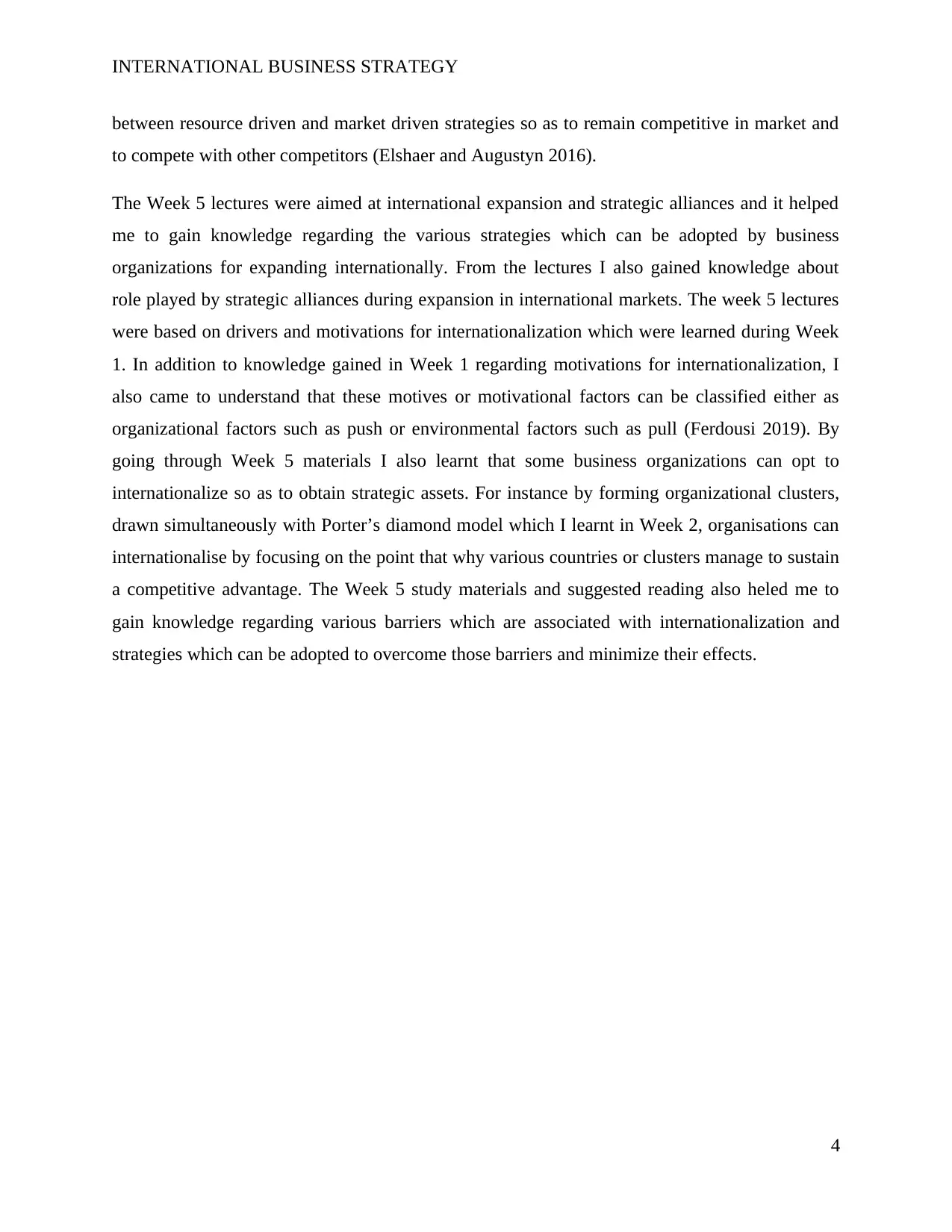
INTERNATIONAL BUSINESS STRATEGY
between resource driven and market driven strategies so as to remain competitive in market and
to compete with other competitors (Elshaer and Augustyn 2016).
The Week 5 lectures were aimed at international expansion and strategic alliances and it helped
me to gain knowledge regarding the various strategies which can be adopted by business
organizations for expanding internationally. From the lectures I also gained knowledge about
role played by strategic alliances during expansion in international markets. The week 5 lectures
were based on drivers and motivations for internationalization which were learned during Week
1. In addition to knowledge gained in Week 1 regarding motivations for internationalization, I
also came to understand that these motives or motivational factors can be classified either as
organizational factors such as push or environmental factors such as pull (Ferdousi 2019). By
going through Week 5 materials I also learnt that some business organizations can opt to
internationalize so as to obtain strategic assets. For instance by forming organizational clusters,
drawn simultaneously with Porter’s diamond model which I learnt in Week 2, organisations can
internationalise by focusing on the point that why various countries or clusters manage to sustain
a competitive advantage. The Week 5 study materials and suggested reading also heled me to
gain knowledge regarding various barriers which are associated with internationalization and
strategies which can be adopted to overcome those barriers and minimize their effects.
4
between resource driven and market driven strategies so as to remain competitive in market and
to compete with other competitors (Elshaer and Augustyn 2016).
The Week 5 lectures were aimed at international expansion and strategic alliances and it helped
me to gain knowledge regarding the various strategies which can be adopted by business
organizations for expanding internationally. From the lectures I also gained knowledge about
role played by strategic alliances during expansion in international markets. The week 5 lectures
were based on drivers and motivations for internationalization which were learned during Week
1. In addition to knowledge gained in Week 1 regarding motivations for internationalization, I
also came to understand that these motives or motivational factors can be classified either as
organizational factors such as push or environmental factors such as pull (Ferdousi 2019). By
going through Week 5 materials I also learnt that some business organizations can opt to
internationalize so as to obtain strategic assets. For instance by forming organizational clusters,
drawn simultaneously with Porter’s diamond model which I learnt in Week 2, organisations can
internationalise by focusing on the point that why various countries or clusters manage to sustain
a competitive advantage. The Week 5 study materials and suggested reading also heled me to
gain knowledge regarding various barriers which are associated with internationalization and
strategies which can be adopted to overcome those barriers and minimize their effects.
4
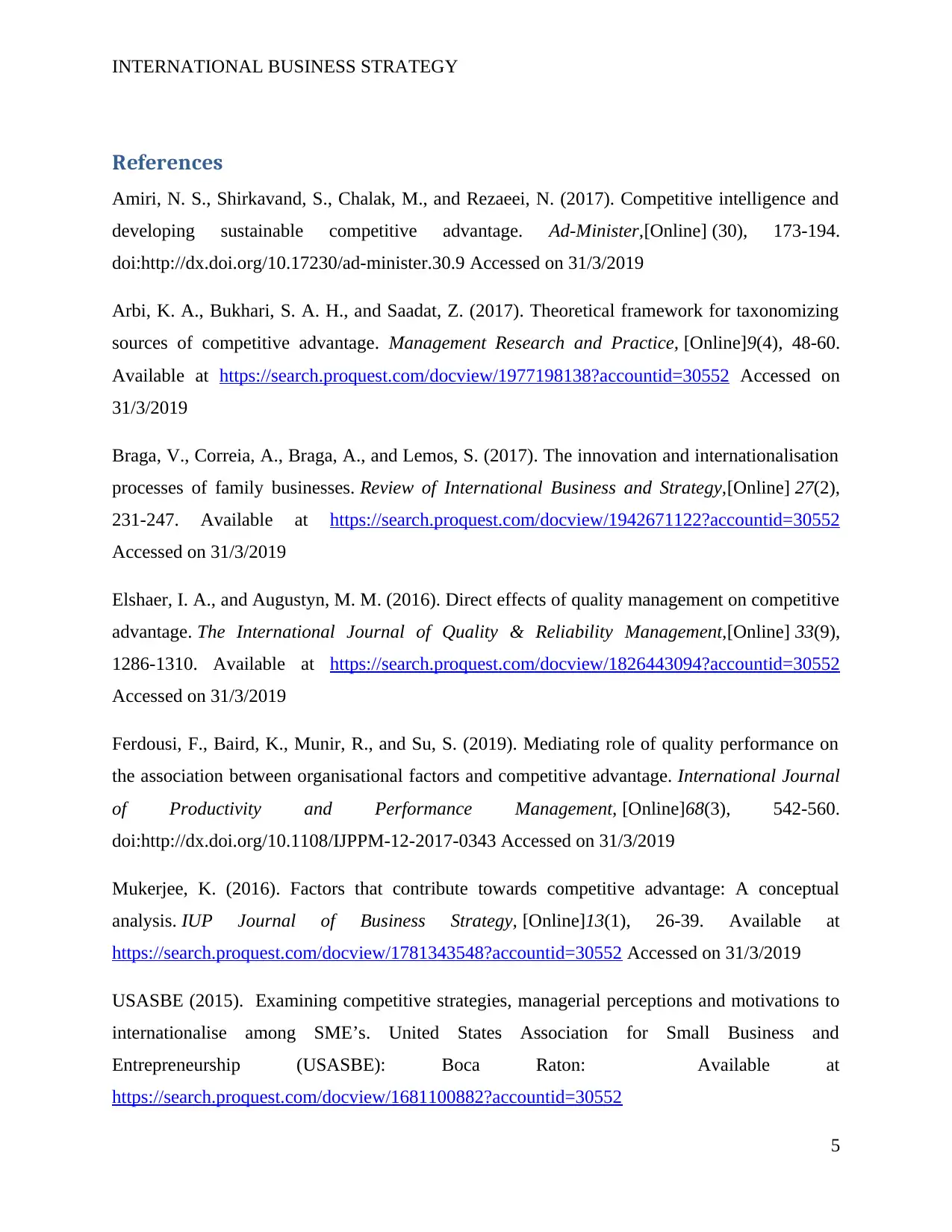
INTERNATIONAL BUSINESS STRATEGY
References
Amiri, N. S., Shirkavand, S., Chalak, M., and Rezaeei, N. (2017). Competitive intelligence and
developing sustainable competitive advantage. Ad-Minister,[Online] (30), 173-194.
doi:http://dx.doi.org/10.17230/ad-minister.30.9 Accessed on 31/3/2019
Arbi, K. A., Bukhari, S. A. H., and Saadat, Z. (2017). Theoretical framework for taxonomizing
sources of competitive advantage. Management Research and Practice, [Online]9(4), 48-60.
Available at https://search.proquest.com/docview/1977198138?accountid=30552 Accessed on
31/3/2019
Braga, V., Correia, A., Braga, A., and Lemos, S. (2017). The innovation and internationalisation
processes of family businesses. Review of International Business and Strategy,[Online] 27(2),
231-247. Available at https://search.proquest.com/docview/1942671122?accountid=30552
Accessed on 31/3/2019
Elshaer, I. A., and Augustyn, M. M. (2016). Direct effects of quality management on competitive
advantage. The International Journal of Quality & Reliability Management,[Online] 33(9),
1286-1310. Available at https://search.proquest.com/docview/1826443094?accountid=30552
Accessed on 31/3/2019
Ferdousi, F., Baird, K., Munir, R., and Su, S. (2019). Mediating role of quality performance on
the association between organisational factors and competitive advantage. International Journal
of Productivity and Performance Management, [Online]68(3), 542-560.
doi:http://dx.doi.org/10.1108/IJPPM-12-2017-0343 Accessed on 31/3/2019
Mukerjee, K. (2016). Factors that contribute towards competitive advantage: A conceptual
analysis. IUP Journal of Business Strategy, [Online]13(1), 26-39. Available at
https://search.proquest.com/docview/1781343548?accountid=30552 Accessed on 31/3/2019
USASBE (2015). Examining competitive strategies, managerial perceptions and motivations to
internationalise among SME’s. United States Association for Small Business and
Entrepreneurship (USASBE): Boca Raton: Available at
https://search.proquest.com/docview/1681100882?accountid=30552
5
References
Amiri, N. S., Shirkavand, S., Chalak, M., and Rezaeei, N. (2017). Competitive intelligence and
developing sustainable competitive advantage. Ad-Minister,[Online] (30), 173-194.
doi:http://dx.doi.org/10.17230/ad-minister.30.9 Accessed on 31/3/2019
Arbi, K. A., Bukhari, S. A. H., and Saadat, Z. (2017). Theoretical framework for taxonomizing
sources of competitive advantage. Management Research and Practice, [Online]9(4), 48-60.
Available at https://search.proquest.com/docview/1977198138?accountid=30552 Accessed on
31/3/2019
Braga, V., Correia, A., Braga, A., and Lemos, S. (2017). The innovation and internationalisation
processes of family businesses. Review of International Business and Strategy,[Online] 27(2),
231-247. Available at https://search.proquest.com/docview/1942671122?accountid=30552
Accessed on 31/3/2019
Elshaer, I. A., and Augustyn, M. M. (2016). Direct effects of quality management on competitive
advantage. The International Journal of Quality & Reliability Management,[Online] 33(9),
1286-1310. Available at https://search.proquest.com/docview/1826443094?accountid=30552
Accessed on 31/3/2019
Ferdousi, F., Baird, K., Munir, R., and Su, S. (2019). Mediating role of quality performance on
the association between organisational factors and competitive advantage. International Journal
of Productivity and Performance Management, [Online]68(3), 542-560.
doi:http://dx.doi.org/10.1108/IJPPM-12-2017-0343 Accessed on 31/3/2019
Mukerjee, K. (2016). Factors that contribute towards competitive advantage: A conceptual
analysis. IUP Journal of Business Strategy, [Online]13(1), 26-39. Available at
https://search.proquest.com/docview/1781343548?accountid=30552 Accessed on 31/3/2019
USASBE (2015). Examining competitive strategies, managerial perceptions and motivations to
internationalise among SME’s. United States Association for Small Business and
Entrepreneurship (USASBE): Boca Raton: Available at
https://search.proquest.com/docview/1681100882?accountid=30552
5
⊘ This is a preview!⊘
Do you want full access?
Subscribe today to unlock all pages.

Trusted by 1+ million students worldwide
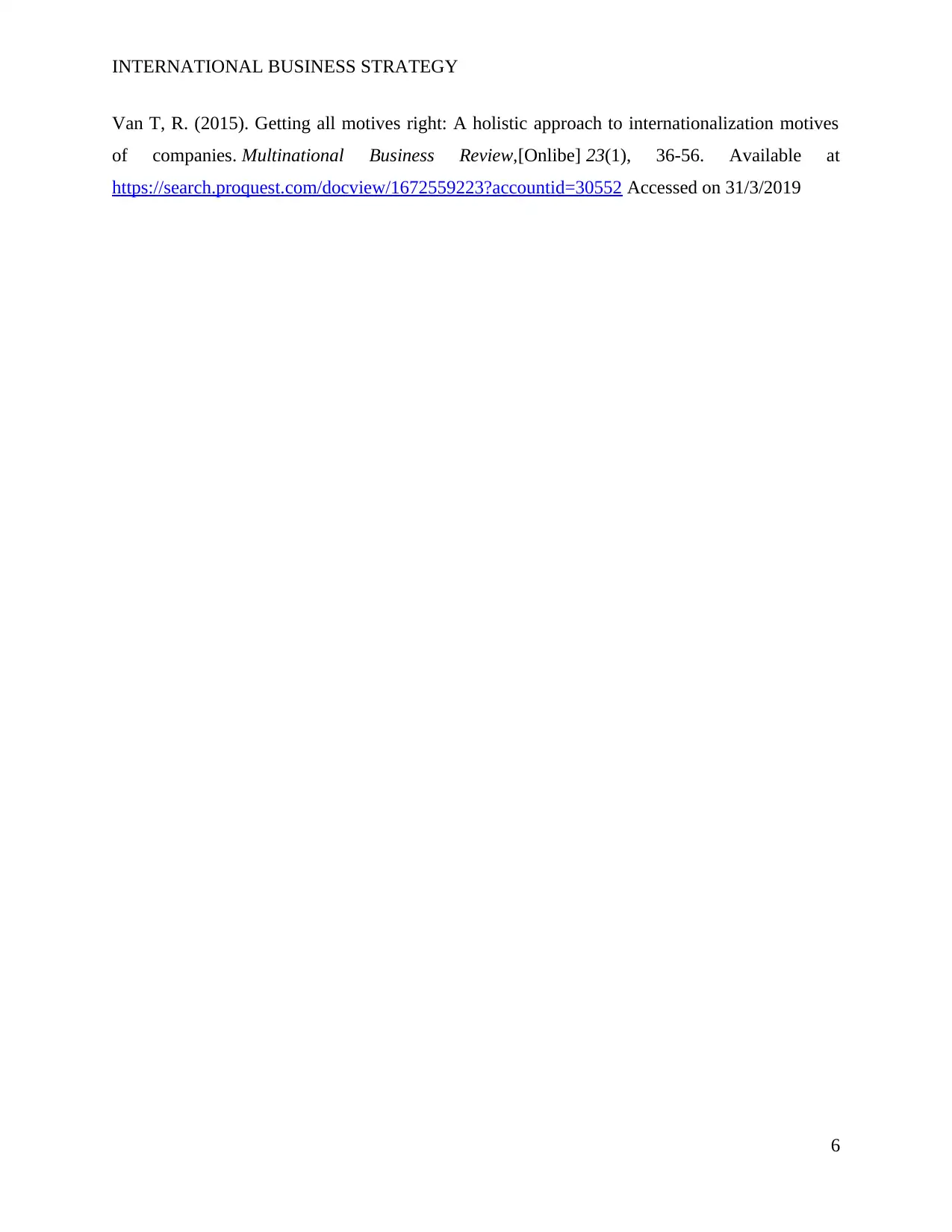
INTERNATIONAL BUSINESS STRATEGY
Van T, R. (2015). Getting all motives right: A holistic approach to internationalization motives
of companies. Multinational Business Review,[Onlibe] 23(1), 36-56. Available at
https://search.proquest.com/docview/1672559223?accountid=30552 Accessed on 31/3/2019
6
Van T, R. (2015). Getting all motives right: A holistic approach to internationalization motives
of companies. Multinational Business Review,[Onlibe] 23(1), 36-56. Available at
https://search.proquest.com/docview/1672559223?accountid=30552 Accessed on 31/3/2019
6
1 out of 7
Related Documents
Your All-in-One AI-Powered Toolkit for Academic Success.
+13062052269
info@desklib.com
Available 24*7 on WhatsApp / Email
![[object Object]](/_next/static/media/star-bottom.7253800d.svg)
Unlock your academic potential
Copyright © 2020–2025 A2Z Services. All Rights Reserved. Developed and managed by ZUCOL.




